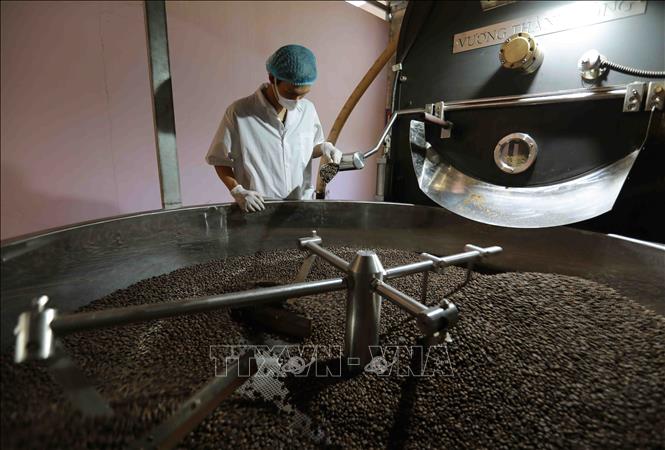
Processing coffee beans at Vuong Thanh Cong Manufacturing and Trading Company Limited in Buon Ma Thuot city, Dak Lak province. Photo: Vu Sinh/Vietnam News Agency
Domestic coffee prices have surpassed 130,000 VND/kg, exceeding pepper prices. Regarding exports, according to the General Department of Customs, as of April 15, Vietnam has exported approximately 660,000 tons of coffee with a turnover of over USD 2.23 billion. The average coffee export price in the first quarter of 2024 reached USD 3,289/ton, an increase of 48% compared to the same period last year. However, in the first half of April 2024 alone, the average coffee export price increased sharply, reaching USD 3,790/ton.
According to the Vietnam Coffee – Cocoa Association (Vicofa), prices are rising but Vietnam’s coffee supply is dwindling. Inventories in businesses and among farmers are low, so exports will decline from now until the end of the season.
Mr. Do Ha Nam, Vice Chairman of the Vietnam Coffee – Cocoa Association, said: In the first six months of the 2023 – 2024 coffee season (from October 2023 to March 2024), Vietnam exported 956,000 tons of coffee, with a total turnover of over USD 3 billion. Thus, Vietnam has exported approximately 60% of the total estimated output of 1.6 – 1.7 million tons for the current season.
With current domestic coffee prices, coffee farmers in the Central Highlands will profit significantly if they have any remaining inventory. Many farmers regret not having any more stock to sell. Additionally, due to the limited supply in the market, purchasing businesses continue to struggle to find products.
According to Mr. Le Duc Huy, Director of Dak Lak 2-9 Import-Export Limited Liability Company, the conversion of crops by farmers has impacted the domestic coffee supply. There is still coffee in the community, but it is limited. Farmers who have held onto their stock until now have generally been able to cover their expenses and secure funding for crop care, so they will not sell.
“The new season is still six months away, so it is difficult to predict future coffee prices,” said Mr. Huy.
According to Mr. Le Duc Huy, most businesses are hesitant to sign contracts unless they have secured a supply of goods. Most businesses anticipated the challenges in production, so they have already purchased enough for their current commitments. With the current significant price increase, buyers are generally more cautious and will only purchase when necessary.
Mr. Nguyen Nam Hai, Chairman of the Vietnam Coffee – Cocoa Association, commented: Coffee prices have never been higher. The sharp price increase has reduced businesses’ purchasing power and disrupted the supply chain for businesses that buy and sell over long distances; futures contracts carry significant risk.
While Vietnam’s new coffee harvest will not begin until October 2024, the severe drought conditions currently affecting the Central Highlands have raised concerns among farmers about next season’s coffee production.
Despite the substantial investment required for coffee trees, particularly given high fertilizer prices and ongoing drought-related irrigation costs, many farmers who had previously neglected their coffee trees have resumed investing in them.
Furthermore, concerns about supply shortages due to prolonged hot and dry weather in major coffee-producing countries in Southeast Asia, including Vietnam, drove the price of Robusta coffee futures on the London market to over USD 4,000/ton at one point. This is the highest level since the coffee futures contract began trading in 2008.
According to Carlos Mera, head of agricultural commodities at Rabobank (Netherlands), the prolonged hot weather in Southeast Asia has significantly impacted coffee production, exacerbating current supply constraints and prompting coffee processors to increase their purchases. Furthermore, processors are attempting to build up their inventories before the European Union (EU) implements a new law in December of this year prohibiting the import of coffee grown on deforested land.
Meanwhile, global coffee bean consumption is expected to increase by 20% in 2023-2024 compared to 2013-2014, with significant growth in Asia. The United States Department of Agriculture (USDA) reports that consumption in major producing countries such as Indonesia has increased by 90%. Similarly, China, the world’s seventh-largest coffee consumer, has experienced a 130% increase. Market attention is focused on the upcoming Brazilian coffee season, as Brazil is the world’s largest coffee supplier.
In light of significant challenges such as declining acreage due to crop conversion and climate change leading to reduced production, Mr. Le Duc Huy believes that it is imperative for members of the coffee supply chain to address challenges collaboratively and work together to share knowledge and support mutual growth. Simultaneously, it is essential to identify and gradually eliminate unreliable and opportunistic businesses and partners from the supply chain. Additionally, key coffee-growing regions in the Central Highlands should implement measures to increase coffee production and quality through varietal and orchard improvements, adoption of new cultivation techniques, and adaptation to climate change.












